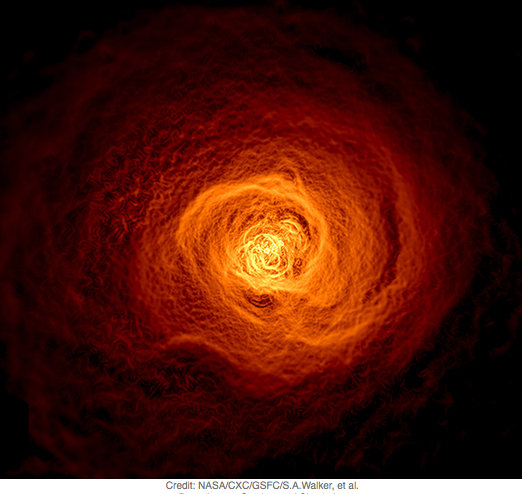
Astrophysicists used data from NASA’s Chandra X-ray Observatory in conjunction with radio observations and computer simulations to find the origin of one of the mysterious features that have been observed in the Perseus galaxy cluster.
The Perseus cluster, named for its host constellation, is one of the most massive nearby clusters, spanning 11 million light-years across and located about 240 million light-years away. It is also the brightest one in X-rays. These X-rays are emitted by its hot gas that reaches temperatures that average to tens of millions of degrees. Previous Chandra X-ray observations have revealed a number of structures in this gas, like vast bubbles blown by the supermassive black hole in the centre of the cluster and an enigmatic feature known as “bay”. Radio observations using the Karl G. Jansky Very Large Array have shown that the bay is not associated with black hole activity.
In an attempt to explain the nature of this bay, astronomers took new, more detailed Chandra observations and combined them with computer simulations. In one of these simulations, gas in a cluster similar to Perseus, is settled into two components, a “cold” central region with temperatures around 30 million degrees Celsius and a surrounding zone where the gas is three times hotter. Then a small galaxy cluster with mass around a thousand times the mass of our Milky Way passes nearby the cluster causing a gravitational instability that creates an expanding spiral of cold gas. 2.5 billion years later, vast waves form and roll at its periphery for hundreds of millions of years before dissipating. Matching the detailed characteristics of the Perseus cluster we observe in X-rays with those produced in the simulation, astronomers think that the bay feature in Perseus has been created by the same mechanism used in the simulation.
The researchers also detected similar features in other galaxy clusters, Centaurus and Abell 1795. The size of these features seems to be associated with the strength of the cluster’s magnetic field. If the field is weak, the waves reach much larger sizes than those observed. If too strong, they don’t form at all.
This study allows astronomers to study the magnetic field of these galaxy clusters, a measurement that is impossible to make by any other means.
Publication: Parker et al. 2017
Source: Chandra
